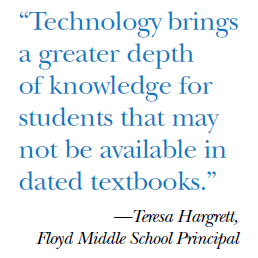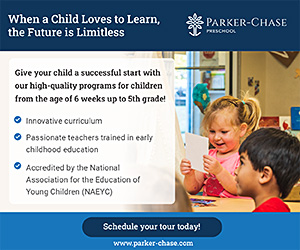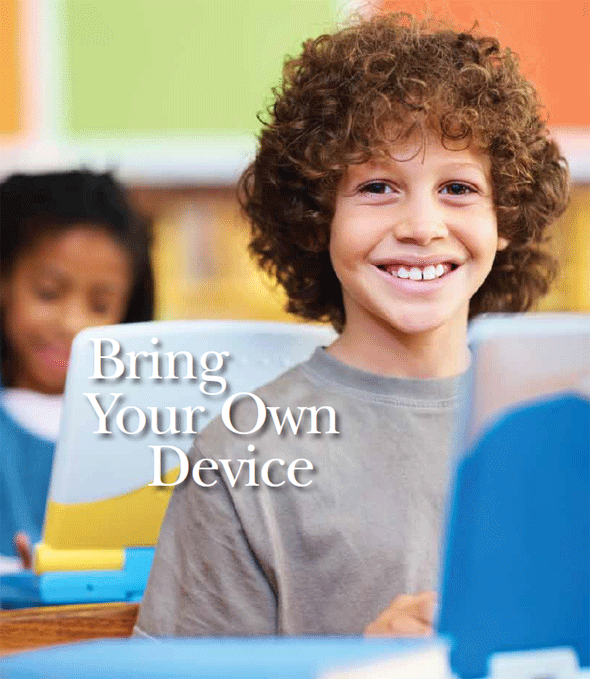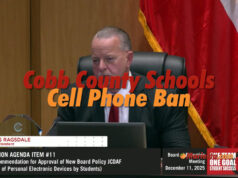Cobb County schools are meeting the challenges of keeping up with new technology by thinking outside the box. Instead of banning cellphones from campuses, schools are embracing mobile devices and laptops to help stretch their technology dollars and provide students with a more modern approach to education. They are beginning to emulate post-secondary institutions by encouraging students to bring personal devices to the classroom, learn by collaboration and spend more one-on-one time with teachers.
Three Cobb County middle schools have launched a pilot program called Bring Your Own Device (BYOD) to help keep up with technology in a time when funds are limited and technology is evolving at warp speed. They’ve also begun using a concept called the flipped classroom, where teachers share lessons via video in an effort to help them spend more valuable classroom time working one-on-one with students on their assignments.
Tapping into Resources to Keep Up with Learning
“Trends are telling us that we cannot afford the model for public education that we have now,” says Dr. Michael Hinojosa, superintendent of the Cobb County School District. “We are going to have to change and adapt. The flipped classroom and Bring Your Own Device are just two examples of how we can do things differently by utilizing technology at low cost, with the goal of further engaging students.”
Daniell, Floyd and Lost Mountain middle schools began implementing this new approach with the start of the 2012–2013 school year in August. “Teachers and staff are very excited to have the opportunity to bring these tools into the classroom,” says Candace Wilkes, principal at Lost Mountain Middle School. “They give students and educators access to a wealth and depth of information and knowledge that is not readily available without having them in the classroom on a regular basis. They allow us to engage in topics and find the most up-to-date information in real time.” The program at Lost Mountain focuses on the eighth grade advanced content classes. “These young people have used computers and other digital devices most of their lives,” notes Wilkes. “It’s what they know and how they communicate. It will make engaging and connecting with them much easier.”
 Currently, students in middle schools share desktop computers at designated times. Having the ability to use their own laptops or mobile devices will further engage them in learning. Floyd Middle School Principal Teresa Hargrett says she sees this new program as a way to tap into the wealth of information. “We understand that students learn in a variety of ways and must be users of information that is so abundantly available,” Hargrett says. “Technology brings a greater depth of knowledge for students that may not be available in dated textbooks.”
Currently, students in middle schools share desktop computers at designated times. Having the ability to use their own laptops or mobile devices will further engage them in learning. Floyd Middle School Principal Teresa Hargrett says she sees this new program as a way to tap into the wealth of information. “We understand that students learn in a variety of ways and must be users of information that is so abundantly available,” Hargrett says. “Technology brings a greater depth of knowledge for students that may not be available in dated textbooks.”
Teachers spent this past summer preparing for the BYOD program. They attended workshops and learned how to integrate technology into lesson plans, shared teaching strategies with peers and peer experts and developed their programs for the current school year. They repeatedly worked with the technology to familiarize themselves and become well versed in how the devices work and how they can be assets to teaching.
Technology at Private Schools
Private schools, where funds are more readily available due to endowments and annual fund drives, are also embracing technology to aid in teaching and interactive learning. Schools like Mt. Bethel Christian Academy and North Cobb Christian School expose students to technology early on through computer labs or computer carts. By the middle school grade levels, students at North Cobb Christian have a Bring Your Own Device program with laptops, Kindles, Nooks or iPads. At Mt. Bethel, the school provides middles school students with their own laptops that they can take home.
“All middle school students have their own laptop that they use and care for daily, both at school and at home,” says Jim Callis, head of Mt. Bethel Christian Academy. “As a preparatory school, we teach our students that there is not a formal boundary between the classroom as a learning environment and the world. We understand that our students are being raised in a world that is increasingly infused with technology. This isn’t a new trend and it isn’t going away.”
Megan Strange, middle and upper school principal at North Cobb Christian, sees technology in the classroom as a necessity. “Technology can help students excel in a number of 21st century learning skills—collaboration, communication, creativity and critical thinking,” she says. “Our hope is that our students will have a seat at the table of influence in their communities as they grow up. For them to make wise decisions, they must have all the information readily available. Technology makes this happen in a way that has never been available to prior generations.”
The ways in which different private schools use technology may prove to be instructive for Cobb public schools. For example, middle school students at Whitefield Academy bring laptops and cellphones to class only at certain times. “We are engaging in significant, in-depth research on the topic of allowing more access for students during the school day,” says Kevin Bracher, academic dean at Whitefield. “We are taking great care to be extremely intentional in this area because we have seen endless examples of technology being used in schools without enough forethought and research. We are committed to making sure that every dollar spent on instructional learning is a dollar toward improved student learning.”
David Lowery, director of marketing and public relations at Mount Paran Christian School, sees technology as an inevitable progression in the educational arena. “Technology is a tool—a means to an end,” says Lowery. “Technology is going to be almost seamlessly integrated into students’ lives. Increasingly, the use of classroom technology is supporting the enhanced personalization of the learning process.”
Lowery agrees that current access to information is unprecedented. The school’s concern, he says, is that the students are able to differentiate between information that is applicable and accurate and information that is not. “We have an even greater responsibility to help students discern what information is valid and what isn’t,” he says. “We must commit ourselves to equipping our students with the ability to think deeply about the messages they are taking in, and then to discern what is valid and what is not.”
Preparation for the Real World
“Using technology serves as an advantage to students,” says David Nelson, principal of Daniell Middle School. “The job skills and the world we lived in 20 years ago are markedly different from the world today’s students are growing up in and will be working in. From typewriters to desktops and smartphones to social media, the world is constantly changing.” Nelson says Daniell strives to teach students how to be successful in high school and, subsequently, to be life-long learners. He believes that in order for educators to be effective, they have to teach students how to integrate new thoughts into their existing behaviors, while also developing the skills to defend their positions and evaluate their own thoughts.
Some critics of technology in the classroom think that allowing digital devices encourages time-wasting or plagiarism, but schools are trying to get ahead of that possibility. With more interactive learning, teachers no longer stand behind podiums and lecture. They move about the classroom and can observe how their students are using technology for meaningful applications. “If we allow students to bring these tools into the school setting, we need to make sure we take the time to teach them to be conscientious digital citizens,” Wilkes says. “Significant time is being spent addressing issues of plagiarizing, appropriate interaction with others and how to tell if websites are reliable.”
Mt. Bethel’s Callis explains that when students bring technology into the classroom, they better replicate the real world. “Computer use is more integrated and organic,” he says. “We’re putting technology where the kids are and this allows our teachers to enrich and extend the learning experience. It’s especially good in a question-response setting because students can text in their answers and receive their scores in real time.”
Today’s students, whether they’re bound for college, technical school or employment, need the exposure to technology in the way that Cobb schools are introducing it in the classroom. “The use of a myriad of technological devices helps make learning more relevant to students,” Nelson says. “By using technology and creating a performance-based product, students are able to begin acquiring the skills identified by business leaders which are needed in the 21st century workforce.”
Today’s educators are realizing the need to examine new learning techniques, and they are approaching them with their eyes wide open. “We will try these initiatives on a very small scale to see how well they work and what challenges they present. They may not work out, but we won’t know that until we try,” Hinojosa says. “On the optimistic side, these initiatives have the potential to fundamentally change the way we deliver instruction to students and put us in better position to lead the future of education.”

















